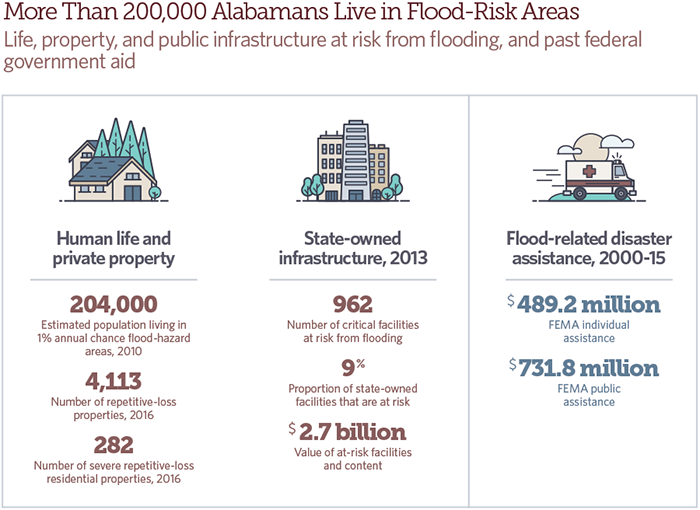Alabama
Flood risk and mitigation
Overview
Floods and hurricanes are becoming more intense in Alabama, and flooding is the state’s second-most common natural hazard, occurring on average every 12 days.1 The state receives about 56 inches of rainfall annually, creating a high risk of riverine and flash flooding, and coastal counties such as Mobile and Baldwin are susceptible to storm surge from tropical storms and hurricanes.2 As these events become more serious, the physical and economic damage to communities and the threats to human lives and ecosystems also increase. Between 2000 and 2015, 27 federal disasters and emergencies were declared for floods, hurricanes, and severe storms in Alabama that exceeded $1 billion in total assistance from the U.S. government.3

Federal flood insurance helps communities prepare
Seventeen communities in Alabama participate in the National Flood Insurance Program’s Community Rating System. The voluntary program provides reduced insurance premiums in communities that proactively implement flood plain management practices—such as acquisition and relocation of flood-prone structures, elevation of structures, and flood proofing—that exceed the program’s minimum requirements.4 The highest-rated communities in the state are Baldwin County and Birmingham, which each earned 20 percent discounts for eligible properties.5
Importance of policy
Communities must prepare for weather-related catastrophes such as floods and hurricanes, and U.S. policymakers should consider reforms that improve protection and preparation; minimize disruptions to the economy; and reduce costs to the federal government and taxpayers by:
- Increasing federal investment in proactive mitigation programs that help communities prepare for and reduce risk of floods.
- Improving resilience and durability requirements for infrastructure that is rebuilt after disasters.
- Protecting ecosystems, such as wetlands, salt marshes, and dunes, which can absorb storm impacts and help shield property.
- Reforming the National Flood Insurance Program to better reflect actual risk, ensure sufficient financial reserves, and compel communities and homeowners to be more proactive in preparing for floods.

Endnotes
- U.S. Department of Energy, Office of Electricity Delivery and Energy Reliability, “State of Alabama Energy Sector Risk Profile” (2015), http://www.energy.gov/sites/prod/files/2015/05/f22/AL-Energy%20Sector%20Risk%20Profile.pdf.
- Alabama Emergency Management Agency, State Hazard Mitigation Plan Update (April 2013), http://ema.alabama.gov/filelibrary/AL Standard State Mitigation Plan.pdf.
- Sum of individual assistance and public assistance for Alabama flood-related major disaster and emergency declarations from 2000 to 2015. Federal Emergency Management Agency, “Disaster Declarations,” accessed May 2, 2016, https://www.fema.gov/ disasters.
- National Flood Insurance Program, “Community Rating System (CRS),” https://www.floodsmart.gov/floodsmart/pages/crs/ community_rating_system.jsp.
- Federal Emergency Management Agency, “Community Rating System” (May 1, 2014), http://www.fema.gov/media-library-data/1398878892102-5cbcaa727a635327277d834491210fec/CRS_Communites_May_1_2014.pdf.













